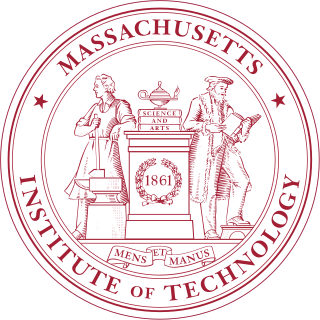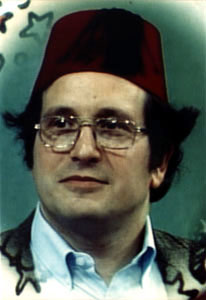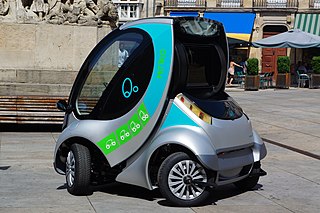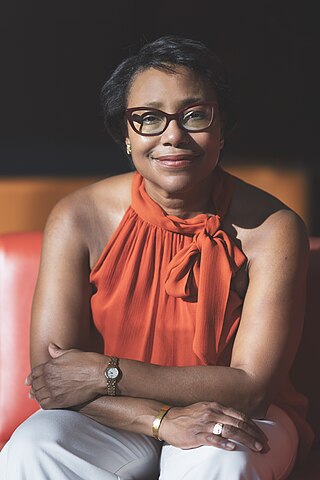Related Research Articles

The Massachusetts Institute of Technology (MIT) is a private research university in Cambridge, Massachusetts, United States. Established in 1861, MIT has played a significant role in the development of many areas of modern technology and science.

Gerald Jay Sussman is the Panasonic Professor of Electrical Engineering at the Massachusetts Institute of Technology (MIT). He has been involved in artificial intelligence (AI) research at MIT since 1964. His research has centered on understanding the problem-solving strategies used by scientists and engineers, with the goals of automating parts of the process and formalizing it to provide more effective methods of science and engineering education. Sussman has also worked in computer languages, in computer architecture, and in Very Large Scale Integration (VLSI) design.

Computer Science and Artificial Intelligence Laboratory (CSAIL) is a research institute at the Massachusetts Institute of Technology (MIT) formed by the 2003 merger of the Laboratory for Computer Science (LCS) and the Artificial Intelligence Laboratory. Housed within the Ray and Maria Stata Center, CSAIL is the largest on-campus laboratory as measured by research scope and membership. It is part of the Schwarzman College of Computing but is also overseen by the MIT Vice President of Research.

Draper Laboratory is an American non-profit research and development organization, headquartered in Cambridge, Massachusetts; its official name is The Charles Stark Draper Laboratory, Inc. The laboratory specializes in the design, development, and deployment of advanced technology solutions to problems in national security, space exploration, health care and energy.

Cynthia Breazeal is an American robotics scientist and entrepreneur. She is a former chief scientist and chief experience officer of Jibo, a company she co-founded in 2012 that developed personal assistant robots. Currently, she is a professor of media arts and sciences at the Massachusetts Institute of Technology and the director of the Personal Robots group at the MIT Media Lab. Her most recent work has focused on the theme of living everyday life in the presence of AI, and gradually gaining insight into the long-term impacts of social robots.

Rodney Allen Brooks is an Australian roboticist, Fellow of the Australian Academy of Science, author, and robotics entrepreneur, most known for popularizing the actionist approach to robotics. He was a Panasonic Professor of Robotics at the Massachusetts Institute of Technology and former director of the MIT Computer Science and Artificial Intelligence Laboratory. He is a founder and former Chief Technical Officer of iRobot and co-founder, Chairman and Chief Technical Officer of Rethink Robotics and is the co-founder and Chief Technical Officer of Robust.AI.
Selmer Bringsjord is a professor of Computer Science and Cognitive Science and a former chair of the Department of Cognitive Science at Rensselaer Polytechnic Institute. He also holds an appointment in the Lally School of Management & Technology and teaches artificial Intelligence (AI), formal logic, human and machine reasoning, and philosophy of AI.

The MIT Museum, founded in 1971, is part of the Massachusetts Institute of Technology in Cambridge, Massachusetts. It hosts collections of holography, technology-related artworks, artificial intelligence, architecture, robotics, maritime history, and the history of MIT. Its holography collection of 1800 pieces is the largest in the world, though only a few selections from it are usually exhibited. As of 2023, works by the kinetic artist Arthur Ganson were the largest long-running displays; in 2024 they were replaced by a newer art installation, but some of Ganson's works were reinstalled elsewhere in the museum. There is a regular program of temporary special exhibitions, often on the intersections of art and technology.

Alex Paul "Sandy" Pentland is an American computer scientist, HAI Fellow at Stanford, Toshiba Professor at MIT, and serial entrepreneur.

Carlo Ratti is an Italian architect, engineer, educator and author. He is a professor at the Massachusetts Institute of Technology where he directs the MIT Senseable City Lab, a research group that explores how new technologies are changing the way we understand, design and ultimately live in cities. Ratti is also a founding partner of the international design and innovation office CRA-Carlo Ratti Associati, which has offices in Turin, New York and London. He is also a Distinguished Professor in the Department of Architecture, Built Environment and Construction Engineering at the Politecnico di Milano and an Honorary Professor at TTPU Tashkent. Ratti was named one of the "50 most influential designers in America" by Fast Company and highlighted in Wired magazine's "Smart List: 50 people who will change the world".

The MIT School of Architecture and Planning is one of the five schools of the Massachusetts Institute of Technology in Cambridge, Massachusetts. Founded in 1865 by William Robert Ware, the school offered the first architecture curriculum in the United States and was the first architecture program established within a university. MIT's Department of Architecture has consistently ranked among the top architecture/built environment schools in the world.
Daniela L. Rus is a Romanian-American computer scientist. She serves as director of the MIT Computer Science and Artificial Intelligence Laboratory (CSAIL), and the Andrew and Erna Viterbi Professor in the Department of Electrical Engineering and Computer Science (EECS) at the Massachusetts Institute of Technology. She is the author of the books Computing the Future, The Heart and the Chip: Our Bright Future with Robots, and The Mind's Mirror: Risk and Reward in the Age of AI.

The Singapore University of Technology and Design (SUTD) is a public autonomous university in Singapore.

The CityCar or MIT CityCar is an urban all-electric concept car designed at the Massachusetts Institute of Technology Media Lab. The project was conceived by William J. Mitchell and his Smart Cities Research Group. It is now led by Kent Larson, Director of the Changing Places Research Group at the Media Lab. The project came into reality in 2003 under the support of General Motors. Time magazine choose the CityCar to be one of the "Best Inventions of 2007".
Living labs are open innovation ecosystems in real-life environments using iterative feedback processes throughout a lifecycle approach of an innovation to create sustainable impact. They focus on co-creation, rapid prototyping & testing and scaling-up innovations & businesses, providing joint-value to the involved stakeholders. In this context, living labs operate as intermediaries/orchestrators among citizens, research organisations, companies and government agencies/levels.

William John Mitchell was an Australian-born author, educator, architect and urban designer, best known for leading the integration of architectural and related design arts practice with computing and other technologies.

The Hiriko is a folding two-seat urban electric car that was under development by the Hiriko Driving Mobility consortium in the Basque Country of northern Spain. The electric car was to be the commercial implementation of the CityCar project developed by the Massachusetts Institute of Technology Media Lab since 2003. The name Hiriko comes from the Basque word for "urban" or "from the city".

Paula Therese Hammond is an Institute Professor and the Vice Provost for Faculty at the Massachusetts Institute of Technology (MIT). She was the first woman and person of color appointed as head of the Chemical Engineering department. Her laboratory designs polymers and nanoparticles for drug delivery and energy-related applications including batteries and fuel cells.

Gerbrand Ceder is a Belgian–American scientist who is a professor and the Samsung Distinguished Chair in Nanoscience and Nanotechnology Research at the University of California, Berkeley. He has a joint appointment as a senior faculty scientist in the Materials Sciences Division of Lawrence Berkeley National Laboratory. He is notable for his pioneering research in high-throughput computational materials design, and in the development of novel lithium-ion battery technologies. He is co-founder of the Materials Project, an open-source online database of ab initio calculated material properties, which inspired the Materials Genome Initiative by the Obama administration in 2011. He was previously the Founder and CTO of Pellion Technologies, which aimed to commercialize magnesium-ion batteries. In 2017 Gerbrand Ceder was elected a member of the National Academy of Engineering, "For the development of practical computational materials design and its application to the improvement of energy storage technology."
Gazebo is an open-source 2D/3D robotics simulator that began development in 2002. In 2017, development forked into two versions, known as "Gazebo", the original monolithic architecture, and "Ignition", which had moved to becoming a modernized collection of loosely coupled libraries. Following a trademark obstacle in 2022 regarding their use of the name "Ignition", Open Robotics took the opportunity to switch the version names, dubbing the original fork "Gazebo Classic" and the new, modern fork "Gazebo".
References
- 1 2 3 "Kent Larson Overview". MIT Media Lab. Massachusetts Institute of Technology. Retrieved 2024-01-16.
- ↑ "City Science". MIT Media Lab. Massachusetts Institute of Technology. Retrieved 2024-01-16.
- ↑ "Norman Foster Institute on Sustainable Cities". NFI. Norman Foster Foundation. Retrieved 2024-01-16.
- ↑ "On Sustainable Cities by Norman Foster Institute". Dezeen. Dezeen Limited. 23 June 2023. Retrieved 2024-01-16.
- ↑ "City Science Network". Massachusetts Institute of Technology. Retrieved 2024-01-16.
- 1 2 "Ori Living". Ori Design Studio. Ori, Inc. Retrieved 2024-01-16.
- ↑ "L3cities". L3cities.com. Larson Living Labs. Retrieved 2024-01-16.
- ↑ "ichim 99 speakers". archimuse.com. Archives & Museum Informatics. Retrieved 2024-01-16.
- ↑ "Open Source Building". Daylight & Architecture. Velux. Spring 2006. Archived from the original on 2006-03-01. Retrieved 2024-01-16. Alt URL
- ↑ Goldberger, Paul (February 1992). "Architecture: Modifying Mies". Architectural Digest. Condé Nast. Retrieved 2024-01-16.
- ↑ Pressman, Andy (1995). The Fountainheadache: the politics of architect-client relations. New York: Wiley. p. 107. ISBN 9780471309925.
- ↑ Larson, Kent (September 1993). "A Virtual Landmark". Progressive Architecture. Reinhold. pp. 80–87.
- ↑ "The Best Design of 1993". Time. New York: Time. January 3, 1994. Retrieved 2024-01-16.
- ↑ Larson, Kent (2000). Louis I. Kahn: Unbuilt Masterworks. New York: Monacelli. ISBN 9781580930147.
- ↑ Filler, Martin (December 3, 2000). "Editors' Choice: The 10 best books of 2000". New York Times Book Review. New York: The New York Times Company. Archived from the original on 2024-01-15. Retrieved 2024-01-16.
{{cite magazine}}: CS1 maint: bot: original URL status unknown (link) - ↑ "TED Speakers Profile of Kent Larson". ted.com. TED Conferences, LLC. June 2012. Retrieved 2024-01-16.
- ↑ "MIT CityHome". MIT Media Lab. Massachusetts Institute of Technology. Retrieved 2024-01-16.
- ↑ Randall, Eric (June 6, 2014). "MIT Wants to Furnish Your Tiny Apartment". Boston Magazine. Metro Corp. Retrieved 2024-01-16.
- ↑ Lawrence, Tyson T. (2003). Chassis + infill: A consumer-driven, open source building approach for adaptive, mass customized housing (Master of Science thesis). Massachusetts Institute of Technology. hdl:1721.1/89903 . Retrieved 2024-01-16.
- ↑ Larrea-Tamayo, Hasier. (2015). ARkits: Architectural robotics kits (Master of Science thesis). Massachusetts Institute of Technology. hdl:1721.1/98627 . Retrieved 2024-01-16.
- ↑ Lonergan, Ronan (2011). The robotic fac̦ade: A design solution for energy conservation in the CityHome of the future (Master of Science thesis). Massachusetts Institute of Technology. hdl:1721.1/68949 . Retrieved 2024-01-16.
- ↑ Sheiber, Jonathan (May 31, 2017). "Ori Systems brings the robotic furniture of the future to apartments today". TechCrunch. Yahoo. Retrieved 2024-01-16.
- ↑ "MIT CityScope". MIT Media Lab. Massachusetts Institute of Technology. Retrieved 2024-01-16.
- ↑ "CityScope GitHub". MIT Media Lab. Massachusetts Institute of Technology. Retrieved 2024-01-16.
- ↑ Noyman, Ariel (2022). CityScope: An Urban modeling and Simulation Platform (Ph.D. thesis). Massachusetts Institute of Technology. hdl:1721.1/145128 . Retrieved 2024-01-16.
- ↑ Alonso, Luis; et al. (2018). "CityScope: A Data-Driven Interactive Simulation Tool for Urban Design. Use Case Volpe". Unifying Themes in Complex Systems IX. Springer Proceedings in Complexity. Vol. 9. pp. 253–261. doi:10.1007/978-3-319-96661-8_27. ISBN 978-3-319-96660-1 . Retrieved 2024-01-16.
- ↑ Grignard, Arnaud; et al. (2018). "Cityscope Andorra: a multi-level interactive and tangible agent-based visualization". Proceedings of the 17th International Conference on Autonomous Agents and MultiAgent Systems: 1939–1940. Retrieved 2024-01-16.
- ↑ Grignard, Arnaud; et al. (2020). "CityScope Hanoi: Interactive simulation for water management in the Bac Hung Hai irrigation system". 2020 12th International Conference on Knowledge and Systems Engineering (KSE) (PDF). pp. 153–158. doi:10.1109/KSE50997.2020.9287831. ISBN 978-1-7281-4510-5 . Retrieved 2024-01-16.
- ↑ Noyman, Ariel; et al. (2017). "Finding places: HCI platform for public participation in refugees' accommodation process". Procedia Computer Science. 112: 2463–2472. arXiv: 1811.10123 . doi:10.1016/j.procs.2017.08.180 . Retrieved 2024-01-16.
- ↑ Sprandel, Anselm (2018). "Housing and integrating refugees in Hamburg". Field Actions Science Reports (18): 20–25. Retrieved 2024-01-16.
- ↑ "Finding Places". Urban Sustainability Exchange. Metropolis. Retrieved 2024-01-16.
- ↑ "Hiriko electric car folds up to take one-third of a parking spot, pilot program to begin next year". TheVerge. 26 January 2012. Retrieved 2024-01-16.
- ↑ "M.I.T. CityCar, Renamed Hiriko, Is Headed to Production". The New York Times. 25 January 2012. Retrieved 2024-01-16.
- ↑ "Persuasive Electric Vehicle". MIT Media Lab. Massachusetts Institute of Technology. Retrieved 2024-01-16.
- ↑ "Persuasive Electric Vehicle,2014". Cooper Hewitt Museum. Smithsonian Design Museum. Retrieved 2024-01-16.
- ↑ "Autonomous Bicycle Project". MIT Media Lab. Massachusetts Institute of Technology. Retrieved 2024-01-16.
- ↑ "The MIT Autonomous Bicycle Is a Regular Bike That Becomes Self-Driving Trike". autoevolution. SoftNews Net S.R.L. 18 August 2020. Retrieved 2024-01-16.
- ↑ Claudel, Matthew (2018). "From organizations to organizational fields: The evolution of civic innovation ecosystems". Technology Innovation Management Review. 8 (6): 34–37. doi: 10.22215/timreview/1163 . Retrieved 2024-01-16.
- ↑ Ferronato, Priscilla; Mercer, Lisa; Roberts-Smith, Jennifer; Ruecker, Stan (2019). "Living Labs and the DH Centre: Lessons for Each from the Other". KULA: Knowledge Creation, Dissemination, and Preservation Studies. 3 (1): 14. doi: 10.5334/kula.46 . Retrieved 2024-01-16.
- ↑ Eriksson, M., Niitamo, V. P., & Kulkki, S. (2005). State-of-the-art in utilizing Living Labs approach to user-centric ICT innovation-a European approach. Lulea: Center for Distance-spanning Technology. Lulea University of Technology Sweden: Lulea.
- ↑ Intille, S. S., Larson, K., Beaudin, J., Tapia, E. M., Kaushik, P., Nawyn, J., & McLeish, T. J. (2005). The PlaceLab: A live-in laboratory for pervasive computing research (video). Proceedings of PERVASIVE 2005 Video Program.
- ↑ Roberts, Jr., Glenn (December 24, 2004). "PlaceLab studies interaction with home tech". South Coast Today. The Standard-Times. Retrieved 2024-01-16.
- ↑ Pervasive 10 Year Impact Award
- ↑ Larson, Kent (June 2012). "Brilliant designs to fit more people in every city". TED. TED Conferences, LLC. Retrieved 2024-01-16.